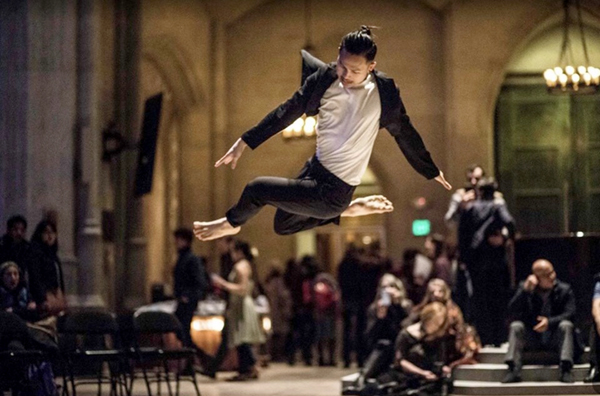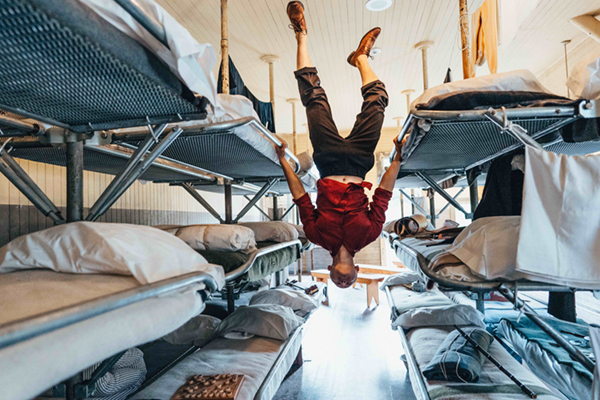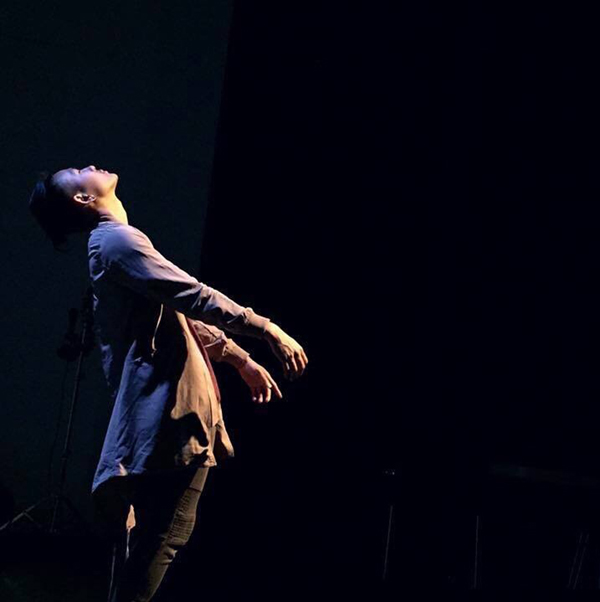To Connect and Understand Through Dance
An Interview with Hien Huynh
BY EMMALY WIEDERHOLT
Originally from Vietnam, Hien Huynh is a freelance dancer and choreographer in San Francisco. He shares his incredible story of how he came to dance, as well as a glimpse into some of the many projects he is involved with and how they inform his own approach to movement and choreography.
Hien Huynh in the San Francisco Movement Arts Festival 2019, Photo by Jane Hu
~~
Can you tell me a little about your dance history?
I started dancing in middle school. After school, there was a break dance program. I asked my parents if I could join, since I needed their signature. They said no because they perceived it to be dangerous and not educational. I was really disappointed, so I forged their signature and told them I was taking math classes after school. They’d pick me up and I’d be all sweaty, but I told them I had been at math club. That was my introduction to dance.
Toward high school and college, I took more dance classes that the school offered. I was also improvising at home and trying to understand what it is to move. In college, my parents weren’t supportive of me spending so much time dancing. I was studying Communications at UC Davis. At the same time, I took dance composition classes through the Theater and Dance department, so my time was shared between the two fields of study. My parents were still not supportive of dance. Finally, I received an assignment through Echo Theater Suitcase to ask my parents how we got to America. They told me about their journey right after the Vietnam War.
My parents tried to flee Vietnam on small fishing boats. If you were caught leaving, you were deemed a traitor by the country and could be executed or imprisoned. My parents were willing to take that risk for better living circumstances. My mom at that time had my oldest sister who was seven months old. She arrived at the boat first but was caught by a militant and taken to prison. My dad arrived and couldn’t find my mother and so decided to leave with the other villagers. They started sailing through the ocean. People started dying because they were running out of food and water. They were finally rescued by a Chinese fishing boat that took my dad to Hong Kong. From Hong Kong, he flew on a refugee plane to Hawai’i and started working as a fisherman. After 10 years, he had saved enough money to go back to Vietnam and look for my mother. They reunited and he met my sister who was 10 years old at that point, and they became a family again. The following year, I was born, and then we immigrated to Oakland.
When I learned this story, I had so much gratefulness for all they did and had been through. This assignment turned into a dance piece to share their story. I invited them both to the performance, which was their first time seeing a dance show. They came and I was dancing and trying to embody my mother and understand her pain and struggle. I saw her crying, and suddenly I was crying too. My dad started crying next. It was our first time crying together as a family. I realized how healing and powerful movement can be. I felt walls come down between my parents and me, and there was so much understanding and compassion in that moment. I realized that this is what I wanted to do for the rest of my life, to connect and understand through dance. That’s been the main fire that’s driven me to pursue this.
What are you currently involved with? Are there one or two projects you want to share more info on?
I have upcoming shows with the choreographers Lenora Lee and Deborah Slater, as well as with Kinetech Arts, a company that integrates dance and technology together.
With Lenora Lee, I’m performing May 4-19 in a site-specific piece called Within These Walls/Dreams of Flight on Angel Island State Park, which was at one time a U.S. immigration station. Each dancer was given a biography of someone detained in the confinement center. Over 100,000 people were processed there, and specifically the Chinese were treated in oppressive conditions. For the performance, we disperse throughout the entire building – two stories and multiple rooms – and the audience chooses who they want to follow and get to witness what happens through the characters.
I performed this piece two years ago in 2017. I recall this woman who was following me to every single room, and she came to two or three shows. At the end, I found out that I was playing the role of her father. I cried so much after realizing that. My world was shaken up; I felt something seismic.
Hien Huynh of Lenora Lee Dance in Within These Walls, Photo by Robbie Sweeny
This time around, we’re revisiting the original piece, Within These Walls, and also presenting a sequel, Dreams of Flight. I am playing the same character as two years ago, so I had lunch with the woman and learned more about her father, what his dreams were, and what ended up happening to him. This time around, I feel like there’s more space to honor him.
With Deborah Slater, I’m performing in Solos Lost & Found May 31-June 2 at the San Francisco International Arts Festival. We’re revisiting one of her solos she choreographed in 1984. It involves a slanted table but, in a sense, it’s more like a crab or insect in a shell seeking shelter but also confined through its symbiotic relationship.
With Kinetech Arts, we’re exploring ideas about the heart in Resonant Frequencies, which will be performed at ODC Theater on May 16-17. In that piece, there’s a lot of technology that measures the heartbeat and projects it live through audio. Each dancer is connected to a heart sensor that sends a wifi signal to the technician. Through sensing and resonating with the vibration of the heart, body and space, the dancers calibrate and negotiate their kinetic energy with one another and the audience. The more our heartbeat levels rise as we dance, the more changes the audience sees within the environment.
From your perspective, what makes a choreographer enjoyable to work with?
I love the exchange of honoring each other’s voices and having a dialogue of what truths come out through the movement. I really enjoy improvisation, whether it becomes choreographic material or it’s a score to improvise within the piece.
You’re involved in so many projects! How do you decide what to say “yes” to?
In the beginning, I wanted to be open to experience different avenues and discover what my values are as a dancer. More recently, I want to invest more energy into what I feel is in alignment with love and compassion.
What are your own choreographic ambitions?
This past March, I did a duet with my mom. She had never performed before. She flew from Vietnam and we spent seven days together creating a piece, and we got to share it at the Asian Art Museum. I wanted to honor her life and honor our relationship, as well as simply spend time with her and meet each other in each other’s world. I wanted her to feel what it felt like to be seen and heard. Within the piece, we got to grieve my older sister’s passing, which we hadn’t done yet as a family. At the end of the piece, I brought my siblings on and we started crying as a family. It was great to align what I do as an artist with my family and see how possible it is for us to come together in that way.
In general, I’m interested in exploring my own voice and making space to channel stories and voices that are unspoken.
How has your experience working for other choreographers influenced your own approach to choreography?
I learn so much; the choreographers I work with also serve as mentors to me. I get to witness them have ideas and evolve, and this sheds light on what I can do. I owe a lot to those I work with, whether they’re dancers, choreographers or collaborators.
How have you seen the Bay Area dance scene change during the time you’ve been there?
I’ve witnessed spaces close, and space in general becoming more limited. At the same time, I’m seeing so much innovation. The Bay Area embraces site specific work, so we’re making dance outside of studios more and more. We’re all over town – on islands, in buildings, outside. It’s beautiful to see that innovation happen.
What’s your next project or focus?
I just want to keep honing in on consciousness and awareness of what I’m moved by and what is beyond me. How also, the frequencies of love illuminate compassion and interconnectedness. If I can deepen myself, that will help me contribute better to the companies I’m involved in. So it’s two simultaneous things – to deepen an understanding of the vibrations of life and deepen an awareness of the collective cosmos to feel how I can be in service.
Hien Huynh in CounterPulse Edge Residency 2017, Photo by Todd Thomas Brown
~~
To learn more, visit www.hien-huynh.com.



